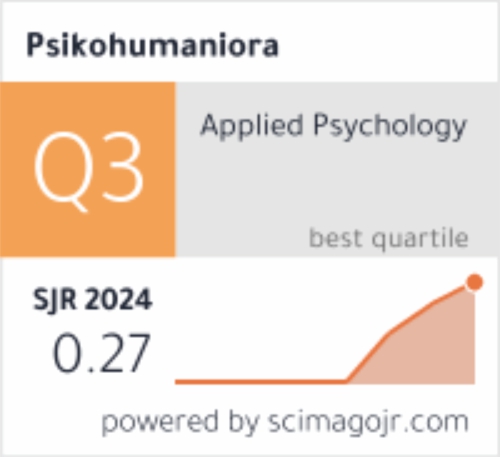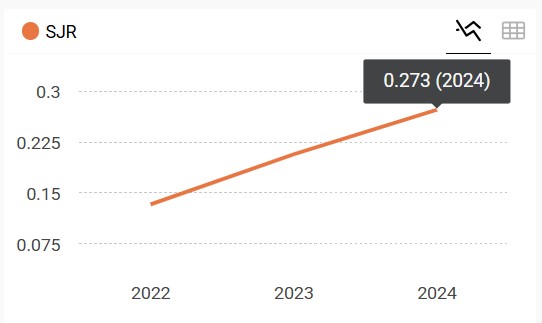Komitmen Beragama dan Kepuasan Perkawinan pada Pasangan yang Bekerja Menjadi Tenaga Kerja Indonesia
DOI:
https://doi.org/10.21580/pjpp.v2i2.2172Keywords:
religious commitment, marital satisfactionAbstract
Abstract: The aim of the present study was to determine the relationship between religious commitment and marital satisfaction among couples worked as Indonesian Migrant Workers. This study involved 51 samples of married couples and one of whom worked as Indonesian Migrant Workers (TKI) who live in Ponorogo District. The sampling technique used is convenience sampling. Data collection techniques used in this study in the form of scales and checklists. The data analysis in this study done by using correlation technique. Based on result of analysis test obtained that religious commitment have positive correlation with marital satisfaction equal to r = 0,364; p = 0,009.
Abstrak: Penelitian ini bertujuan untuk menguji hubungan antara komitmen beragama dengan kepuasan kerja pada pasangan yang bekerja menjadi tenaga kerja Indonesia di luar Negeri. Penelitian slot zeus ini melibatkan 51 sampel pasangan yang telah menikah dan salah satunya bekerja menjadi Tenaga Kerja Indonesia (TKI) yang tinggal di Kabupaten Ponorogo. Adapun teknik sampling yang digunakan adalah convenience sampling. Adapun teknik pengumpulan data yang digunakan dalam penelitian ini adalah kuesioner dalam bentuk skala. Analisis data dalam penelitian ini dilakukan dengan menggunakan teknik korelasi. Berdasarkan hasil uji analisis diperoleh bahwa komitmen beragama mempunyai korelasi positif dengan kepuasan perkawinan sebesar r= 0,364; p=0,009.
Downloads
References
Abdel-Khalek, A. M. (2007). Religiosity, happiness, health, and psychopathology in a probability sample of Muslim adolescents. Mental Health, Religion & Culture, 10, 571–583. https://doi.org/https://doi.org/10.1080/13674670601034547
Ahmadi, K., Azad-Marzabadi, E., & Ashrafi, S. M. N. (2008). The Influence of Religiosity on Marital Satisfaction. Journal of Social Sciences, 4(2), 103–110. https://doi.org/10.3844/jssp.2008.103.110
Anderson, E. A., & Spruill, J. W. (1992). The Dual-Career Commuter Family: A Lifestyle on the Move. Families on the Move: Migration, Immigration, Emigration, and Mobility, 131–147. https://doi.org/10.1300/J002v19n01_08
Ardhianita, I., & Andayani, B. (2005). Kepuasan pernikahan ditinjau dari berpacaran dan tidak berpacaran. Jurnal Psikologi, 32(2), 101–111. https://doi.org/https://doi.org/10.22146/jpsi.7074
Asmin, S. H. (1986). Status perkawinan antar agama: Ditinjau dari Undang-Undang Perkawinan No. 1/1974. Jakarta: Dian Rakyat.
Balkanlioglu, M. A., & Assist, B. (2013). Questioning The Relationship between Religion and Marriage: Does Religion Affect Long-Lasting Marriage?Turkish Couple’s Practice of, Perception of, and Attitudes Towards Religion and Marriage. The Journal of International Social Research, 7(31), 515–523. Retrieved from http://www.sosyalarastirmalar.com/cilt7/sayi31_pdf/5psikoloji_sosyoloji_felsefe/balkanlioglu_mehmetali.pdf
Brimhall, A. S., & Butler, M. H. (2007). Intrinsic vs. Extrinsic Religious Motivation and the Marital Relationship. The American Journal of Family Therapy, 35(3), 235–249. https://doi.org/https://doi.org/10.1080/01926180600814684
Bukhori, B. (2006). Kesehatan Mental Mahasiswa Ditinjau dari Religiusitas dan Kebermaknaan Hidup. Psikologika: Jurnal Pemikiran dan Penelitian Psikologi, 11(22), 93–106. Retrieved from http://journal.uii.ac.id/Psikologika/article/view/272/7385
Bukhori, B., Hassan, Z., Hadjar, I., & Hidayah, R. (2017). The effect of sprituality and social support from the family toward final semester university students’ resilience. Man in India, 97(19), 313–321.
Butler, M. H., Stout, J. A., & Gardner, B. C. (2002). Prayer as a Conflict Resolution Ritual: Clinical Implications of Religious Couples’ Report of Relationship Softening, Healing Perspective, and Change Responsibility. The American Journal of Family Therapy, 30(1), 19–37. https://doi.org/https://doi.org/10.1080/019261802753455624
Call, V. R. A., & Heaton, T. B. (1997). Religious influence on marital stability. Journal for the Scientific Study of Religion, 36, 382–392. https://doi.org/10.2307/1387856
Clayton, P. R. (1975). The family marriage and social change. Washington DC.: Health and Company.
Delener, N. (1990). The Effects of Religious Factors on Perceived Risk in Durable Goods Purchase Decisions. Journal of Consumer Marketing, 7(3), 27–38. https://doi.org/https://doi.org/10.1108/EUM0000000002580
Departemen Pendidikan dan Kebudayaan. (1991). Kamus besar bahasa Indonesia. Jakarta: Balai Pustaka.
Diener, E., Suh, E. M., Lucas, R. E., & Smith, H. L. (1999). Subjective Well-Being: Three Decades of Progress. Psychological Bulletin, 125(2), 276–302. https://doi.org/10.1037/0033-2909.125.2.276
Dowlatabadi, F. H., Saadat, S., & Jahangiri, S. (2013). The Relationship between Religious Attitudes and Marital Satisfaction among married personnel of departments of education in Rasht City , Iran, 1(6), 608–615.
Fowers, B. J., & Olson, D. (1993). ENRICH Marital Satisfaction Scale: A Brief Research and Clinical Tool. Journal of Family Psychology, 7(2), 176–185. https://doi.org/10.1037/0893-3200.7.2.176
Gelles, R. J. (1995). Contemporary family: A sociological view. Thousand Oaks, CA: Sage Publication Inc.
Gerstel, N., & Gross, H. E. (1982). Commuter marriages: A review. In H. Gross & M. B. Sussman (Eds.), Marriage and family review (5th ed.). New York [N.Y.]: Haworth Press.
Ghufron, M. N., & Risnawita, R. (2010). Teori-teori psikologi. Yogyakarta: Ar-Ruz Media.
Ghufron, M. N., & Risnawita, R. (2015). Sejahtera secara spiritual dengan Pendidikan Agama. In Seminar Nasional Educational Wellbeing. Kudus: Universitas Muria Kudus.
Glock, C. Y., & Stark, R. (1970). American piety: The nature of religious commitment. London: University of California Press.
Goddard, H. W., Marshall, J. P., Olson, J. R., & Dennis, S. A. (2012). Character Strengths and Religiosity as Predictors of Marital Satisfaction in a Sample of Highly Religious and Divorce-Prone Couples. Journal of Couple & Relationship Therapy, 11(1), 2–15. https://doi.org/https://doi.org/10.1080/15332691.2011.613308
Groves, M. M., & Horm-Wingerd, D. M. (1991). Commuter marriage: Personal, family and career issues. Sociology & Social Research, 75, 212–217.
Gullotta, T. P., Adams, G. R., & Alexanders, S. J. (1986). Today’s marriages and families: A wellnes approach. California: Brooks/Cole Publishing Co.
Gunarsa, S. D., & Gunarsa, Y. S. D. (1991). Psikologi praktis anak remaja dan keluarga. Jakarta: BPK Gunung Mulia.
Hawari, D. (1997). Ilmu kedokteran jiwa dan kesehatan jiwa. Yogyakarta: Dana Bhakti Prima Yasa.
Hendrick, & Hendrick, S. (1992). Liking, loving and relating (2nd ed.). California: Brooks Company Pacific Grove.
Himmelfarb, H. S. (1975). Measuring Religious Involvement. Social Forces, 53(4), 606–618. https://doi.org/https://doi.org/10.1093/sf/53.4.606
Hurlock, E. B. (2002). Psikologi perkembangan (5th ed.). Jakarta: Erlangga.
Imannatul Istiqomah, & Mukhlis, M. (2015). Hubungan Antara Religiusitas dengan Kepuasan Perkawinan. Jurnal Psikologi UIN Sultan Syarif Kasim Riau, 11(2), 71–78.
Khanzadeh, H., & Niyazi. (2011). Investigate relationships between religious orientation with public health and marital satisfaction among married students of University of Tehran. Procedia Social and Behavioral Sciences, 15, 505–509.
Klemer, R. (1970). Marriage and the family. New York [N.Y.]: Harper and Row Publisher.
Laswell, J. T., & Laswell, T. (2002). Marriage and the family. California: California Publishing Company.
Manaf, M. A. (1994). Ilmu perbandingan agama. Jakarta: Raja Grafindo Persada.
Mathews, M. (2002). Study of factor contributing to marital satisfaction. KwaDlangezwa: University of Zululand.
Myers, D. (1992). Pursuit of happiness: Discovering the pathway to fulfillment, well-being, and enduring personal joy. New York [N.Y.]: Avon.
Oluwole, & Adebayo, D. (2008). Marital satisfaction: Connection of self disclosure, sexual self-efficacy and spirituality among Nigerian woman. Pakistan Journal of Social Sciences, 5(5), 464–469. Retrieved from http://www.medwelljournals.com/abstract/?doi=pjssci.2008.464.469
Pargament, K. I. (1997). The psychology of religion and coping: Theory, research, practice. New York [N.Y.]: Guilford Publications.
Park, C. L. (2005). Religion and meaning. In R. F. Paloutzian & C. L. Park (Eds.), Handbook of the Psychology of Religion and Spirituality (pp. 295–314). New York [N.Y.]: Guilford Publications.
Robinson, L. C., & Blanton, P. W. (1993). Marital Strengths in Enduring Marriages. Family Relations, 42(1), 38–45. https://doi.org/http://doi.org/10.2307/584919
Stone, E. A., & Shackelford, T. K. (2007). Marital satisfaction. In Encyclopedia of Social Psychology (p. 541–54.). https:// dx.doi.org/10.4135/ 9781412956253.n323
Sukmawati, B. (2014). Hubungan Tingkat Kepuasan Pernikahan Istri dan Coping Strategy Dengan Kekerasan Dalam Rumah Tangga. Sains Dan Prakyik Psikologi, 2(3), 205–218.
Sullivan, K. T. (2001). Understanding the relationship between religiosity and marriage: An investigation of the immediate and longitudinal effects of religiosity on newlywed couples. Journal of Family Psychology, 15(4), 610–626. https://doi.org/10.1037//0893-3200.15.4.610
Sumpani, D. (2008). Kepuasan pernikahan ditinjau dari kematangan pribadi dan kualitas komunikasi. Surakarta: Universitas Muhammadiyah Surakarta. Retrieved from http://eprints.ums.ac.id/851/1/F100010200.pdf
Tiliouine, H., & Belgoumidi, A. (2009). An exploratory study of religiosity, meaning in life and subjective wellbeing in muslim students from Algeria. Applied Research in Quality of Life, 4(1), 109–127. https://doi.org/10.1007/s11482-009-9076-8
Winfield, F. E. (1985). Commuter marriage: Living together, apart. New York [N.Y.]: Columbia University Press.
Worthington, E. L., Wade, N. G., Hight, T. L., Ripley, J. S., McCullough, M. E., Berry, J. W., … O’Connor, L. (2003). The Religious Commitment Inventory-10: Development, refinement, and validation of a brief scale for research and counseling. Journal of Counseling Psychology, 50(1), 84–96. https://doi.org/10.1037/0022-0167.50.1.84
Downloads
Additional Files
Published
How to Cite
Issue
Section
License
Copyright (c) 2017 Psikohumaniora: Jurnal Penelitian Psikologi

This work is licensed under a Creative Commons Attribution-NonCommercial-ShareAlike 4.0 International License.
The copyright of the accepted article shall be assigned to the publisher of the journal. The intended copyright includes the right to publish the article in various forms (including reprints). The journal maintains the publishing rights to published articles.
In line with the license, authors and any users (readers and other researchers) are allowed to share and adapt the material only for non-commercial purposes. In addition, the material must be given appropriate credit, provided with a link to the license, and indicated if changes were made. If authors remix, transform, or build upon the material, authors must distribute their contributions under the same license as the original.




